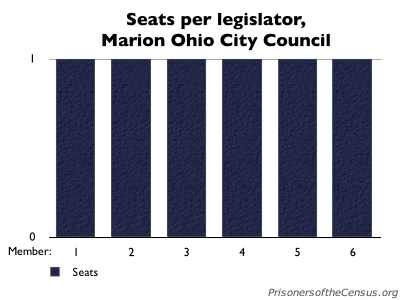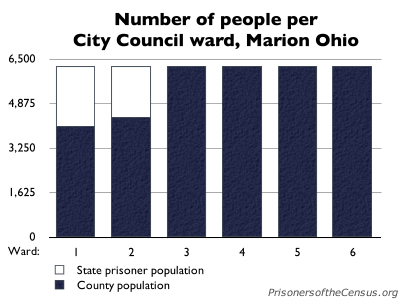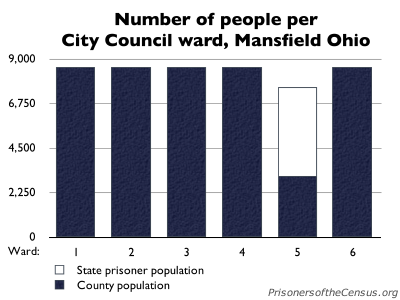Legislative districts belong to the people, not the politicians
by Peter Wagner, August 23, 2004
The mayor of Marion Ohio — which contains a number of large prisons — was quoted in an article about our Importing Constituents: Prisoners and Political Clout in Ohio report as saying that he hasn’t noticed any added clout in the state capitol as a result of the Census Bureau counting state prisoners as residents of his town.
The mayor of one small town within a larger district is not likely to “notice” an increase in his town’s influence over state politics, but the discussion did remind me of a critical point I haven’t been making often enough: In a democracy, districts are supposed to belong to the constituents, not the politicians. When we get this backwards we reduce the constitutional principle of “one person one vote” to the meaningless “one politician per district”.
To show why this matters, let me use an example not discussed in our report but in the Marion Star article: the most recent redistricting of the Marion City Council. In 1996, city annexed nearby prisons which “meant a significant jump in the size of Marion City Councilman Ralph Cumston’s 1st ward”. The solution? “Splitting” two of the facilities off and “putting them in to 2nd ward Councilman Phil Hatch’s ward.”
Admittedly, incumbents are reelected at a very high rate. And true, few citizens who don’t work for campaigning politicians know where the seemingly arbitrary district boundaries are drawn. Together, these factors make the shorthand of writing as if Councilperson Cumston actually owned the ward to be understandable. I’ve made this mistake frequently. But doing so obscures how our democracy is supposed to work.

Every representative gets one seat. This graph is as meaningless as a “democracy” where politicians and not the citizens own the districts.
Does Councilperson Cumston notice that he has extra clout? Probably not. From his perspective, he has just as much clout as he did before the new district boundaries were drawn: he gets the same seat at the Council table and the room is no more or less crowded then before. In other words, the representative’s political power is still equal to that of the other members of the City Council. (See first illustration.)
But in a representative democracy, citizens are organized into equally sized groups of people (districts) and then a representative is chosen to represent those people in the government. The districts are a tool to organize the political power of the citizenry not a perk given to our leaders.
But when districts aren’t equally sized — or when a Census Bureau quirk starts to includes a large number of people in the wrong spot — it’s the citizens that suffer. The Census Bureau counts prisoners as if they lived in the town with the prison. In Ohio like many other places, the prisoners tend to be overwhelmingly from outside the prison town. Crediting the areas with prisons with the population of the prisoners skews the Census’s portrayal of where people live. When states and communities use this data as-is to redraw district boundary lines, they end up diluting the weight of a vote of every resident in the community who doesn’t live next to the prison.

Even after splitting the large prison populations between two districts, there is still a large imbalance in the size of the City Council Wards in Marion.
In contrast to the legislator’s perspective in the first illustration that sees no impact on political clout, see the second illustration that looks at this from the citizen’s perspective. Wards should have about 6,250 residents, but the actual city population of Wards 1 and 2 are just over 4,000. This is like saying that 7 people in Wards 1 or 2 are worth as much as 10 people elsewhere. Seven is not the same as 10.
Having a “government of the people, by the people and for the people” requires citizens to each have an equal ownership stake in their government. But when the districting data is skewed, the value of citizen’s investment in government in diluted. In economic terms, counting prisoners from outside Marion as residents of Wards 1 and 2 meant that every citizen in Wards 3 through 6 saw their investment in their city plummet 30%.
Solutions:
If property taxes were raised 30% in just a just a portion of the city, there would be outrage. If the government suddenly seized 30% of some people’s pensions for arbitrary reasons, people would object. Redistricting and the electoral process is significantly harder to understand than property taxes or pension benefits, but it’s no less important. And as this project has been trying to document it is no longer possible to just rely on Census Bureau data for making these decisions. We need a dataset that accurately counts our communities as they exist in reality and not as they were imagined during the first Census in 1790.
Until the Census Bureau changes the way that the prison population is counted, communities would be well served to adjust the data and subtract all state and federal prisoners for purposes of local redistricting. (And at the state level, the census data could easily be corrected so that all prisoners are actually counted at their home of record.)

Unlike Marion, Mansfield kept all the large prisons in one district. The City Council is saying that 3,100 residents in Ward 5 are to be given the same weight as 8,600 residents elsewhere. This is the same as pretending that the votes of 4 people are equal to the votes of 10.
Marion’s decision to split up the prisons was a good one because it at least diluted the impact of these large external populations. Failing to do that would have led to a district similar to Ward 5 in Mansfield, where 4 residents get as much of a say over city affairs as 10 residents elsewhere. (See 3rd illustration). The only thing that is worse than saying that 7 votes equals 10 is saying that 4 equals 10.
Rural Franklin County in northern New York was faced with drawing similarly lopsided county legislative districts that would have equated 4 votes in some parts of the county with 10 elsewhere. Calling the decision a “no-brainer”, county officials subtracted the prisoners from their local redistricting population. Each legislative district in Franklin County currently contains the same number of county residents, just as it should be.



